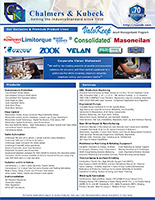BLOG

Three Golden Rules for Severe Service Valves
- 25 Apr 2017
If you’d just bought a new high performance sports car, you’d likely protect your investment by following the manufacturer’s instructions for breaking in the engine. You’d also probably leave the spare tire in the trunk so that a flat wouldn’t leave you stranded on the side of the road.
The same logic applies to sever service valves. These valves protect and control some of a plant’s most essential and costly equipment, such as turbines, compressors and pumps. They handle high-pressure fluids and are integral parts of a plant’s most critical processes. They’re usually costly, custom-designed and highly engineered, making them significant financial investments. It only makes sense, therefore, to take the proper steps when bringing a new plant online and to be prepared to make repairs when the unexpected happens.
By following three simple guidelines, plant operators can keep their plants running efficiently and safely, minimize downtime and maintenance costs, and prevent catastrophic damage to vital equipment.
1. Follow recommended commissioning/start-up procedures when installing a new valve. The use of start-up trim during commissioning ensures that trash in the lines does not damage the valve’s trim and other equipment down the line.
2. Always have recommended spare parts on hand. It will not only reduce downtime, but can save millions of dollars in lost production and rush charges.
3. Whenever possible, install valves with smart positioners and advanced diagnostics that monitor the mechanical condition of the valve and provide early notice of potential issues.Perform Proper Commissioning/Startup
As a plant is constructed or expanded, it is perfectly normal for debris, trash and weld slag to accumulate in the lines. If not flushed out before the plant startup, these materials can clog and damage the valve’s trim, compromising its performance with potentially damaging equipment downstream.
Properly commissioning valves before startup reduces the potential for damage to the valves and other equipment and helps ensure the valves will deliver optimal performance, including tight shutoff when closed, and fast, accurate response when open. That not only protects the plant’s investment and warranty coverage, but also reduces the risk of a costly and time-consuming restart of the plant.
Commissioning involves installing “dummy” trim, gaskets, and packing to protect the valve’s seating surfaces, plug, stems, seat rings, diffusers and cages. This dummy trim has larger holes than the operational trim, allowing slag, debris and trash to easily pass through as the lines are flushed. Once the lines are clean, the dummy trim is replaces with the fully operational trim and normal operation can get underway. Proper startup and commissioning can take several hours to two weeks to complete, depending on the size of the valve and plant. Always complete recommended commissioning procedures before a new plant goes online. Many plant operators include commissioning as part of routine maintenance processes.
Valve manufacturers will usually provide instructions for properly commissioning their valves. Plant operators should emphasize to whoever is installing or maintaining their valves–whether it’s a general contractor, an outside valve technician or an internal maintenance team–the importance of a clean, thorough commissioning process.
It’s a small investment that buys a powerful insurance policy. A severe service or critical valve and cost $500,000 or more. The cost of a commissioning kit is 10% that of the valve itself (or less). That kit will protect not only the valve, but also the equipment that is the very heart of the plant–equipment that can cost 50 times more than the valve.
Take, for example, the $350,000 valve that recently was installed in a new plant. The plant operator opted not to protect its investment with a commissioning kit. Weld rod from an unrelated part of the plant clogged the valve trim, rendering the valve useless. Because it was a custom valve that had been designed and manufactured specifically for this plant, the lead time for replacement trim was significant. The valve manufacturer scrambled to supply the parts as quickly as possible, but the customer still faced delays and additional costs that could have been easily avoided.
Keep Spare Parts on Hand
The Boy Scout motto–“Be Prepared”–certainly applies when it comes to severe service valves. No matter how much care is taken in executing predictive maintenance, the unexpected can and will happen, and they best way to deal with it is having the necessary spare parts on hand.
Valves in severe service applications frequently experience cavitation damage, including erosive-corrosive damage, high liquid velocity erosion and abrasive particulate erosion. Many experience more than one of these erosion types. As a result, most will, at some point, require repairs.Because most severe service valves are so highly customized, manufacturers do not stock trim for them; it is made to order. Some severe service valves also are mad of special materials, such as titanium, Inconel alloys and super duples stainless steel, or require special manufacturing techniques. As a result, turnaround time for these “one-off” parts can be several weeks; four to eight weeks is common, and up to 12 weeks is possible. Without the right spare parts waiting on the shelf, a plant operator could easily face tens of millions of dollars in lost production or be forced to pay expediting fees amounting to two or three times the regular cost of the parts.
Finally, there are some very tangible, powerful benefits to being prepared. These include long-term efficiency and continuous productivity of the plant, consistent reliability of the valves, minimized downtime for maintenance, shutdown schedules that are both predictable and met, and longer valve life.Use Smart Positioners and Advanced Diagnostics
Given the harsh conditions that severe service valves often operate in, it is important to continually monitor a valve’s condition so potential problems can be addressed early on, before they become major issues. Whenever possible, valves should be installed with smart positioners and advanced diagnostics that will raise the red flag at the first sign of galling, sticking and other problems. This way the plant operator or maintenance team can plan ahead and proactively service the valves as needed.
Severe service valves, and the equipment they protect, represent significant capital investments for a plant. It only makes sense to protect that investment and the performance of a facility by correctly commissioning them, continually monitoring their condition, and stocking recommended spare parts.

